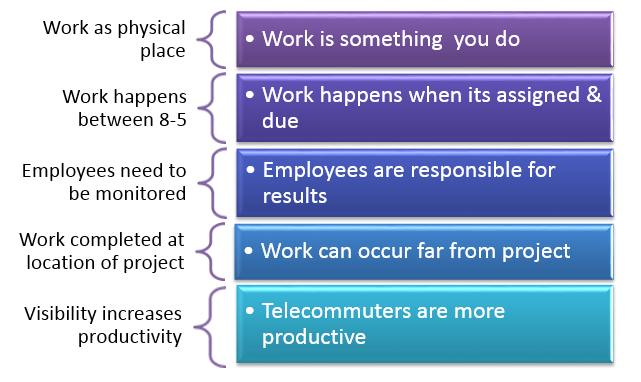Company-wide cohesion is not created with a forced work environment, but rather with good management. In today’s global workforce, the majority of US companies now have some portion of their workforce that works remotely from their main office. Companies now need to do more with less, and having employees based near clients cuts down travel costs and provides quicker service. As well, employees have been proven to be more productive when they can work from a home office, cutting down on commute time and disruptions. This has created a shift in the old assumptions, that all work must be completed in the same office location. However, some have a hard time releasing those assumptions, limiting their corporation’s ability to stay competitive. It’s like the refusal to use an automobile, at the turn of the last century, because of a belief that a horse drawn carriage was more effective. Yes, a horse drawn carriage has some charm to it and was effective for a long time, but eventually they were run over by the automobile and they are no longer a competitive transportation method. You can’t care for an automobile the same way you do for a horse team and the same is true with a telecommuting team. For a remote workforce model to work, it has to be managed correctly. If it is not, it can impact communication and collaboration, as well as encourage non-focused employees. But if it is managed correctly, you will have a much more effective and competitive business model. There are 7 strategies to successfully managing remote/teleworking teams, that differs from regular employee management. Increased Communication – Communication with teleworking employees must be increased. The perception, as expressed by Yahoo, is that you will communicate less with virtual working employees – which will cause the decrease in collaboration and idea sharing that they experienced. Managers need to make a conscious effort to communicate more with teleworking employees, as well as facilitate increased communication between team members, to foster the same level of idea sharing and collaboration. Communication should never be delayed because you can’t walk down the hall to chat with someone. Pick up the phone, send an email or use IM to foster that same chat. It does take some initial assistance to get employees into this routine, but once that is created, it will happen naturally. Create a Team Community – Managers need to make a more concerted effort to create a team community when their teams work remotely. They need to find opportunities for team members to work together, celebrate together, and spend time talking about non-work related things. This helps them get to know each other as individuals, so they can work more effectively together, and feel like a part of an important group. Manage to Goals and Outcomes, Not Tasks – Give employees the responsibility to manage themselves by providing the vision and guidance when needed, rather than explicit instructions that are task focused. Think of a team’s goals as a bowling alley. You want to clearly outline what the goal is – knock down all 10 pins in 2 or less shots by rolling the ball. And you also want to define the boundaries for them to work within – like setting up the bumper guards in the lane. However, after that, you want to leave it to them to decide how to get the ball down the lane to accomplish the goal. Do they roll it fast or slow, do they use curve balls or straight shots, do they bank it off of the bumper guards several times – these decisions should be left in their hands. Enable Team Micro-Monitoring for Accountability – One of the biggest fears when managing a team of remote employees is that they won’t be working and getting the job done when you can’t see them. Unfortunately, this fear can lead to micro-managing employees, which can lead to the direct results you are trying to avoid. Instead of micro-managing employees, have them micro-monitor themselves. Have them hold themselves accountable to their goals and have them report their success, or lack of, to you each week. By clearly setting goals and providing a weekly status report to you, they will hold themselves accountable for their goal attainment. No one wants to come to their manager and tell them they did a bad job. Everyone wants to be able to take pride in their achievements. Having them keep and report their weekly goal attainment status keeps them self-motivated to reach those goals. Ongoing Socratic Coaching – Teleworking employees need to learn how to make the correct decisions in the absence of their manager. The best way to prepare them for this is through Socratic coaching. This coaching method is designed to coach through self-discovery by asking the employee open ended questions to teach a thinking process that enables them to make better decisions in future. Motivate Rather than Move Employees – What many call motivation is often really movement. It is the carrot and stick approach. If an employee does something, they receive a reward, or if they don’t, it’s a punishment. This method must be continuously re-charged, which can quickly fail when employees are not always in the same office. Instead, it’s important to motivate remote working employees by developing their pride and self-esteem in what they do. This is self-charged and will deliver longer lasting motivation. Develop employees pride through giving them ownership of their job through decision making and idea sharing. Also find ways to give them praise and a sense of accomplishment. Create Trust – Trust is critical for teleworking employees to work well as a team and as individuals. Without daily face-to-face contact, trust is more vulnerable to break-down. It takes forever to build trust, but can be destroyed in a minute. Remote employees in particular need to know that their manager respects and trusts them to carry out every day work functions, with little or no supervision. They also



















